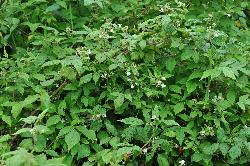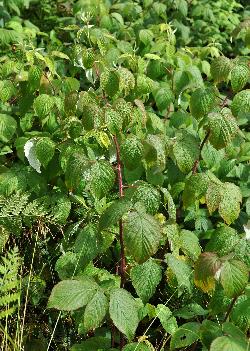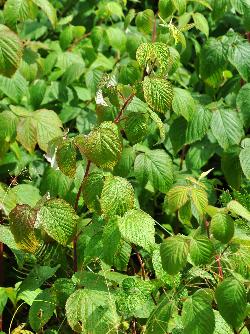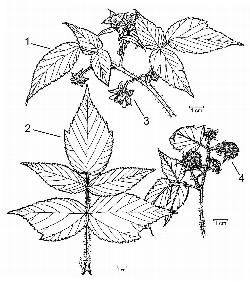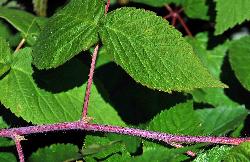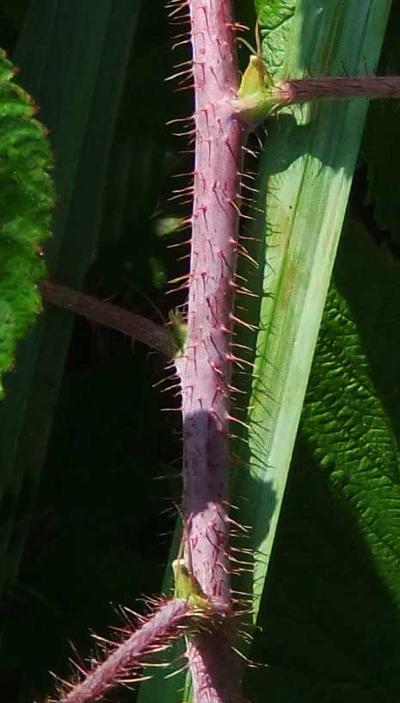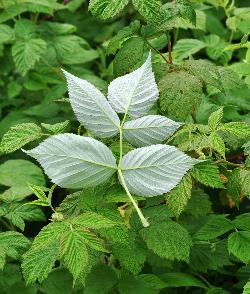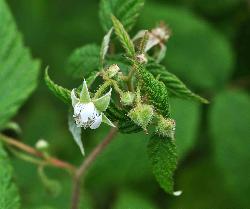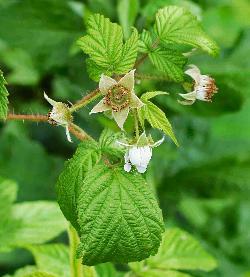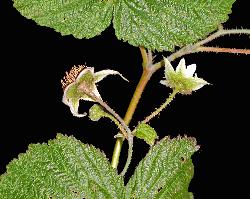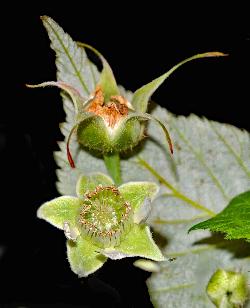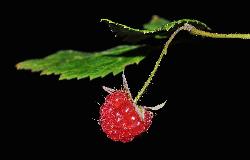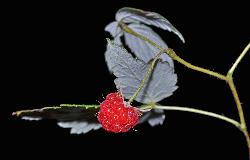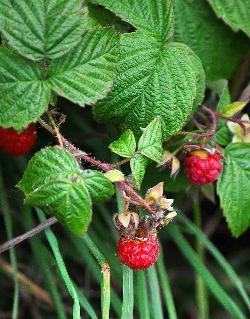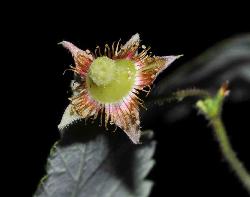Fr: framboisier sauvage
IA: anushkaniminanakashi, anushkan
Rosaceae - Rose Family
Note: Numbers provided in square brackets in the text refer to the image presented above; image numbers are displayed to the lower left of each image.
General: An erect to arching deciduous shrub, 5–1.5 dm tall, with biennial canes (vegetative primocanes and flowering floricanes) that arise from a perennial rootstock. Plants are stoloniferous and often form dense colonies or thickets [1–3]; the canes do not root at the stem tips. Rubus idaeus is represented in North America by subsp. strigosus, and has been treated as separate species, Rubus strigosus Michx., in the past (Britton & Brown 1970); the typical subsp. idaeus, although widely cultivated in North America, is native to Eurasia. Wild red raspberry thickets provide cover for a variety of nesting birds and small mammals; its fruits are eaten by a variety of mammals and birds, but the foliage and twigs are seldom used as browse (Tirmentein 1990). Wild and cultivated red raspberries are an important economic food in North America, providing fruit for preserves, desserts, yogurt, and ice cream, and leaves for tea blends (Tirmentein 1990).
Key Features: (numbers 1–4 refer to the illustration [4]}
1. Leaves of floricanes usually with 3 leaflets; densely white to grey pubescent beneath.
2. Leaves of primocanes usually with 5 leaflets; densely white to grey-pubescent beneath.
3. Flowers axillary, spreading to nodding, solitary, axillary, or in small terminal clusters.
4. Fruit an aggregate of small red drupelets, separating easily from the receptacle.
Stems/twigs: Young stems and twigs are round (terete) in cross-section, about 6 mm in diameter, and reddish, with sparse to numerous, slender, narrow-based prickles, as well as numerous bristly, stipitate-glandular hairs [5]; stems often have a whitish (pruinose) coating [6–7]. Older stems are reddish-brown to dark brown [8], becoming glabrous after the bristle-bearing epidermis shreds off. Lateral buds are alternate, small, scaly, and sharply pointed (acuminate); flower buds, located at or near the stem tips, are ovoid, blunt (obtuse), and larger than vegetative buds. Leaf scars are small and narrowly hemispherical, with a single bundle trace scar.
Leaves: Alternate, pinnately compound, pinnately-veined, petiolate, and stipulate. Petioles bear stipitate-glandular bristles and are about as long as the leaf blade; stipules are narrow, 5–10 mm long, and deciduous. Leaves of vegetative stems (primocanes) usually have 5 leaflets [9–11], occasionally 3 or 7, while leaves of flowering canes (floricanes) have 3 leaflets [12–14]. In primocane leaves with 5 leaflets, the middle pair is situated closer to the terminal leaflet than to the lower pair. The terminal leaflets are 7–15 cm long by 4–11 cm wide and petiolulate; lateral leaflets are smaller, 2–10 cm long, and sessile or nearly so. Leaflet blades are lanceolate to ovate, bases are tapering (cuneate), rounded to cordate, apices are sharply pointed (acuminate) to attenuate, and margins are irregularly and sharply serrate, biserrate, to coarsely lobed. The upper surface of leaflets is mainly glabrous; lower surfaces are pubescent with greyish-white hairs and stipitate glandular hairs [15]. Leaves turn orange-brown to bronze in autumn [16].
Flowers: Bisexual, small, to 1 cm across, nodding, solitary, or borne in small terminal clusters (racemiform cymes) of 2–5 flowers in leaf axils [17–19]; flower stalks (pedicels) and calyx lobes bear numerous stipitate glandular hairs [20]. The calyx is green, glandular-pubescent, with 5 ovate spreading to reflexed lobes that are white-pubescent on the inner surface and acuminate to slightly caudate at the apex [19–22]; calyx lobes are about the same length as the petals. The 5 petals are erect, white, oblanceolate, blunt to rounded at the apex, and 0.5–1 cm long; stamens are numerous and erect [20]; pistils are also numerous [22] and have superior ovaries with slender styles that persist in fruit [23]. Flowers bloom in early to mid-summer and are self-incompatible. Pollination by insects (entomophily) is necessary for fruit and seed set; in one study conducted in a red spruce-balsam fir forest in Maine, a total of 163 different insect taxa visiting Rubus idaeus flowers were collected over a 2 week period; most were pollinators, while some fed on the flowers and pollen. The most frequent pollinators were halictid bees (Dialictus spp.), syrphid flies (38 species), and longhorn (Cerambycidae) beetles (Hansen and Osgood 1983).
Fruit: A rounded, aggregate fruit, to 1 cm across, composed of a cluster of small coherent drupes (an aggregate of 10–60 drupelets), becoming red when mature [23–26]; edible and juicy; easily separating from the narrow conical receptacle (torus) [27]. Fruits mature in late summer to fall and are dispersed primarily by mammals and birds (endozoochory).
Ecology and Habitat: Wild red raspberry occurs in closed forests primarily on moist, medium to very rich sites, usually with an abundance less than 5%. It is also common on wet rich sites in thickets and alder swamps. In early succession following clearcutting and fire, it can rapidly form large patches, with cover approaching 100% on moist rich sites.
Edaphic Grid: See image [28]: the Edaphic Grid for Rubus idaeus subsp. strigosus.
Forest Types: Wild red raspberry is found in low abundance in the following forest types:
Abietum alnetosum (Alder-Balsam Fir Forest Subassociation)
Abietum dryopteretosum (Dryopteris-Balsam Fir Forest Subassociation)
Abietum rubetosum (Rubus-Balsam Fir Forest Subassociation)
Abietum taxetosum (Taxus-Balsam Fir Forest Subassociation)
Aceretum galietosum (Galium-Mountain Maple Thicket Subassociation)
Alnetum dryopteretosum (Dryopteris-Alder-Black Spruce Swamp Subassociation)
Alnetum solidagetosum (Solidago-Alder-Black Spruce Swamp Subassociation)
Alnetum typicum (Moist Alder-Black Spruce Swamp Subassociation)
Alnetum caricetosum (Carex-Alder Swamp Subassociation)
Alnetum lycopodietosum (Lycopodium-Alder Swamp Subassociation)
Betuletum dryopteretosum (Dryopteris-White Birch Forest Subassociation)
Betuletum rubetosum (Rubus-White Birch Forest Subassociation)
Succession: Wild red raspberry can persist under dense coniferous canopies, but in Newfoundland forest vegetation plots, their occurrence is sporadic, rarely exceeding 5% cover outside of canopy openings. Seeds are viable in the forest floor for periods of up to 100 years, but require high temperatures (20°–30° C) for up to 90 days to germinate (Tirmentein 1990). This may explain why wild red raspberry has such low abundance under the forest canopy, but rapidly expands following clearcutting or fire. Wild red raspberry also spreads vegetatively through branch layering, root crowns, root sprouts, rhizomes, and suckers. On nutrient-medium to nutrient-rich moist cutovers in central Newfoundland, wild red raspberry attains coverage of 50–100% within the first 5 years following harvest, but quickly declines to 20–50% cover at 5–10 years post-harvest and less than 10% at 10–15 years as woody thickets progressively develop (Northland Associates 1989). After fire, 70–90% of seeds germinate in the first year, with minimal recruitment in subsequent years. Succession after fire appears to be very similar to harvesting, with most of the plants establishing from buried seed and spreading vegetatively in the first 5 years and then rapidly declining as competition from shrubs and tree regeneration increases (Whitney 1986).
Distribution: Wild red raspberry is a transcontinental boreal species that occurs in all Provinces of Canada. It occurs throughout insular Newfoundland, and extends north in Labrador to about 56°30' N (Scoggan 1978). In the United States, wild red raspberry ranges southwest from Maine to North Carolina and west through most of the northcentral and western States. However, its distribution is most continuous in the northeast, but absent from South Carolina to Texas, as well as Kansas and Kentucky (USDA, NRCS 2016).
Similar Species: The wild red raspberry is the only woody raspberry with erect canes native to Newfoundland and Labrador. Raspberry canes are similar in appearance to those of some blackberries, but blackberries can be distinguished by their palmately compound leaves and have purplish-black aggregate fruits that do not separate from the receptacle. The cultivated raspberry, Rubus idaeus L. subsp. idaeus can be recognized by its wider stems (to 1 cm in diam.) and lack of glandular hairs on the foliage, pedicels, and outer calyx lobes (Alice et al. 2014).


